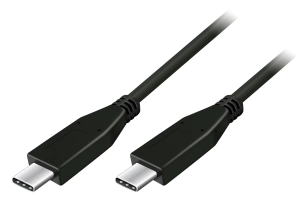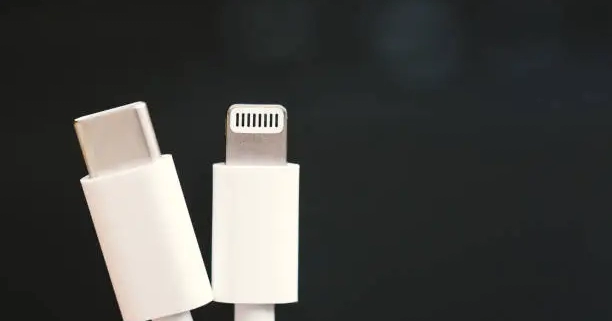If you’ve ever found yourself wondering which charging cable to grab when your phone battery is low, you’re not alone. Today, two main contenders dominate the market: Apple’s Lightning connector and the USB-C standard, which has quickly become the go-to option for most new devices. With Apple recently making the leap from Lightning to USB-C on its latest iPhones, many users are left wondering what this change means for them.
Why does it matter? The choice between Lightning and USB-C isn’t just about the type of cable you use—it affects your device’s charging speed, data transfer rates, and even the overall convenience of your tech setup. Whether you’re an Apple loyalist clinging to your trusty
Lightning cable or someone intrigued by the versatility of USB-C, this article will walk you through the key differences, helping you understand which connector might be the better fit for your needs.
What is the Lightning Connector?
The Lightning connector has been a staple in Apple’s ecosystem since its debut in 2012. Designed specifically for Apple devices, this compact, reversible connector was introduced as a replacement for the bulky 30-pin connector used in earlier iPhones and iPads. The idea was simple: to create a smaller, more efficient connection that could handle charging, data transfer, and audio—all in one sleek, easy-to-use design.
Apple users quickly embraced the Lightning connector for its reliability and ease of use. One of its standout features is its reversible design, allowing you to plug it in without worrying about which side is up—something that might seem trivial today, but was a big deal back then. This small yet thoughtful detail has made the Lightning connector a fan favorite, especially for those who value convenience.
While the Lightning connector has been exclusively used by Apple, it’s become a symbol of consistency within their product lineup. From iPhones and iPads to AirPods and accessories, the Lightning port has maintained a sense of uniformity across Apple’s ecosystem, making it easy for users to stick to one type of cable for all their devices. However, with the recent push toward adopting USB-C, even loyal Apple fans are starting to wonder if it’s time for a change.
What is USB-C?
USB-C has quickly become the new favorite in the tech world, often referred to as the “one cable to rule them all.” Unlike older USB standards that had different types of connectors (like USB-A, and Micro-USB), USB-C was designed to be a universal solution. It’s small, symmetrical, and can be plugged in either way—similar to the Lightning connector’s reversible design, but with far wider adoption across various devices.
What’s the big deal about USB-C? It’s all about versatility. USB-C isn’t just for charging; it can handle fast data transfers, power delivery, and even video output. That’s why you see it being used everywhere—from smartphones and tablets to laptops, game consoles, and even some monitors. Its ability to carry power, data, and video signals all through one port has made it a preferred choice for many manufacturers aiming to simplify their devices.
Another big advantage of USB-C is its speed. With the latest USB-C versions supporting incredibly fast data transfer rates (up to 40Gbps in some cases), it’s far ahead of what the Lightning connector can offer. Plus, USB-C supports faster charging speeds, making it possible to power up devices like laptops and tablets quickly. For many users, this means fewer cables, faster performance, and a more streamlined setup.
That said, the widespread adoption of USB-C isn’t without its challenges. Not all
USB-C cables and ports are created equal—some support high-speed data transfer, while others might only handle basic charging. This can lead to confusion, especially for users who aren’t familiar with the different standards. Still, as more devices standardize around USB-C, it’s becoming clear why this connector is seen as the future.
Head-to-Head Comparison: Lightning vs USB-C
Now that we’ve covered the basics, it’s time to put these two connectors head-to-head and see how they stack up across different categories. Whether you’re trying to decide which cable to use or simply curious about the differences, this comparison will help highlight the strengths and weaknesses of each.
-
Design and Compatibility
The Lightning connector is known for its sleek, compact design, tailored specifically for Apple devices. It’s small, lightweight, and fits seamlessly into the streamlined look of iPhones, iPads, and AirPods. However, it’s exclusive to Apple products, which can be limiting if you use a mix of devices from different brands.
USB-C, on the other hand, is designed to be a universal standard. It’s slightly larger than the Lightning connector but offers broader compatibility across a wide range of devices—Android smartphones, tablets, laptops, and even gaming consoles. This makes USB-C the go-to choice for users who prefer a single cable that works with all their tech.
-
Charging Speed
When it comes to charging speed, USB-C has a clear edge. Many USB-C cables support fast charging with power delivery (PD), allowing devices to charge at much higher wattages. This is why you often see USB-C used for charging high-powered devices like laptops. Although Lightning also supports fast charging on newer iPhones, its power delivery capabilities are limited compared to USB-C, making it less efficient for charging larger devices.
-
Data Transfer Speed
Data transfer speed is another area where USB-C comes out on top. With the latest USB-C versions supporting transfer speeds of up to 40Gbps (e.g., Thunderbolt 4), it’s ideal for tasks like transferring large files, backing up your phone, or even streaming 4K video. The Lightning connector, while sufficient for most everyday uses, is limited by the USB 2.0 standard, which maxes out at 480Mbps. For users who frequently transfer data between devices, this can be a noticeable difference.
-
Durability and Build Quality
Both Lightning and USB-C have reversible designs, reducing wear and tear from incorrect plugging. The Lightning connector, however, is slightly more durable in its construction, with a sturdy design that rarely bends or breaks. USB-C’s versatility comes with a trade-off—its more complex internal structure can be prone to wear over time, especially if the cable or port is used frequently for high-power charging and data transfer.
-
Versatility and Future-Proofing
This is where USB-C shines. It’s not just a charging cable—it can handle data, power, and even video output through a single connection. This versatility makes it ideal for users who want to simplify their tech setup, especially with newer devices that often come with fewer ports. The Lightning connector, in contrast, is focused on simplicity and consistency within the Apple ecosystem but lacks the multifunctionality of USB-C.
Overall, USB-C is positioned as the future of device connectivity, with more manufacturers and even Apple gradually moving towards this universal standard. However, for users who are deeply embedded in the Apple ecosystem, the familiar Lightning connector still offers a reliable and straightforward experience.
The Apple Transition: Why the Move from Lightning to USB-C?
Apple’s shift from Lightning to USB-C marks a pivotal change, driven by evolving user demands and industry trends. While the Lightning connector has long been praised for its compact design and consistency across Apple devices, it started to show its age as users began prioritizing versatility. USB-C offers a universal solution, handling fast charging, data transfer, and video output all in one cable, making it the preferred choice for a wide range of modern gadgets. This transition aligns with a broader move towards simplification, reducing the clutter of multiple cables and enhancing the user experience.
Regulatory pressure, particularly from the European Union, accelerated this change, mandating USB-C as the standard to reduce electronic waste and unify charging methods. Embracing USB-C not only ensures compliance but also sets Apple up for future innovations, supporting faster data speeds and higher power delivery. By making the switch, Apple is effectively preparing its products for the next generation of tech, while offering a more streamlined and universal experience for its users.
Let’s break down the strengths and weaknesses of both Lightning and USB-C, focusing on key factors that matter most to users.
Pros and Cons of Each Connector
Let’s break down the strengths and weaknesses of both Lightning and USB-C, focusing on key factors that matter most to users.
Lightning Connector: Pros and Cons
Pros:
-
Compact and Durable: The Lightning connector’s small size and robust design make it easy to handle and less prone to damage.
-
Apple Ecosystem Integration: Lightning is exclusive to Apple products, providing a consistent experience across iPhones, iPads, and AirPods.
-
Reversible Design: Like USB-C, Lightning can be plugged in either way, avoiding the common frustration of incorrect insertion.
Cons:
-
Limited Compatibility: Lightning only works with Apple devices, which can be inconvenient if you own a mix of gadgets from different brands.
-
Slower Data Transfer: Lightning relies on older USB 2.0 technology, making it significantly slower for data transfers compared to USB-C.
USB-C: Pros and Cons
Pros:
-
Universal Standard: USB-C is widely adopted across various devices, from smartphones to laptops, offering broad compatibility and reducing cable clutter.
-
High-Speed Performance: USB-C supports faster data transfer rates and higher power delivery, making it ideal for quick charging and handling large file transfers.
-
Multifunctional Capabilities: USB-C can transmit data, deliver power, and output video, serving as an all-in-one solution for modern tech needs.
Cons:
-
Inconsistent Standards: Not all USB-C cables and ports offer the same features, leading to confusion about compatibility and performance.
-
Potential Durability Issues: The complex design of USB-C can make it slightly more prone to wear and tear compared to the simpler Lightning connector.
Which Connector is Right for You?
Deciding between Lightning and USB-C comes down to what you value most in your tech experience. If you’re deeply invested in Apple’s ecosystem and appreciate the simplicity and reliability that comes with using one type of cable across your iPhone, iPad, and accessories, the Lightning connector still offers a solid, hassle-free choice. Its compact design and consistent performance make it a great fit for users who prioritize a streamlined, Apple-specific setup.
However, if you’re looking for a more versatile option that works with a wide range of devices beyond just Apple products, USB-C is the way to go. Its universal compatibility is a major advantage, especially if you own gadgets from different brands and want to minimize cable clutter. USB-C’s superior data transfer speeds and fast-charging capabilities also make it an attractive choice for those who need top-tier performance, whether it’s for quick file backups or powering up larger devices like laptops and tablets.
Ultimately, it’s a matter of your tech preferences and future needs. If you’re already surrounded by Apple devices and value a consistent user experience, sticking with Lightning might be more convenient. But for those who want a future-proof, one-cable-for-everything solution, USB-C clearly has the edge, aligning with the broader trend towards a universal connector standard.
Conclusion
In the end, both Lightning and USB-C have their merits, but the tech world is clearly moving toward a universal standard. Lightning has been a reliable staple within Apple’s lineup, but USB-C’s broader compatibility and superior performance are setting it up as the future of connectivity. As Apple transitions to USB-C, it marks the start of a simpler, unified experience for users, bringing us one step closer to a world where one cable does it all.
 28
28
 0
0
 3524
3524
 28
28
 0
0
 3524
3524














Laat een antwoord achter
Uw e-mailadres wordt niet gepubliceerd. Verplichte velden zijn gemarkeerd *